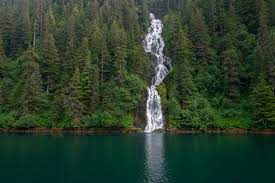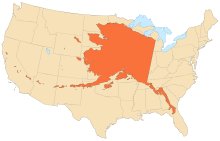Revisiting the Last Frontier
Alaska is a magnificent state. Is its untamed, unspoiled splendor an asset or a defect?
This essay originally appeared in Law & Liberty on July 25, 2022 (here). Thanks to Power Line and Instapundit (here)!
I visited Alaska for the first time four years ago and was impressed enough to write an essay about the trip (Alaska: America’s Last Frontier), which elicited a good-natured response from a pair of political scientists at the University of Alaska, Anchorage, Forrest A. Nabors and James W. Muller. My wife and I recently returned from a second visit to the 49th state—this time to the so-called Panhandle in Southeast Alaska—which provoked some additional thoughts. The riddle of Alaska is why a state with such abundant natural resources remains so sparsely populated and relatively undeveloped. Indeed, with a population of only 734,323 residents, Alaska is by far the least densely-populated state. Visitors are stunned by the state’s beauty and wilderness; some free-market academics see unrealized potential.

Professors Nabors and Muller contend that Alaska’s stunted growth is primarily a function of excessive federal ownership of land there—rendering it a “state by law but a territory in fact”–rather than its remote location or other physical features. Loath as I am to quarrel with denizens of The Last Frontier, and scholars to boot, the question is a bit more complicated than the degree of federal ownership of land in a state. True, about 60 percent of Alaskan land is owned by the federal government, but other western states have similar—or even higher—numbers, without any apparent impairment of their economic development. For example, over 80 percent of Nevada is federally-owned, as is 63 percent of Utah, almost 62 percent of Idaho, nearly 40 percent of Arizona, and, remarkably, 45.4 percent of California. Nationwide, the federal government owns about 28 percent of all U.S. land.

Nabors and Muller also cite the production of oil in Alaska as a factor in the state’s hindered progress, without explaining why the 1901 Spindletop discovery in Texas did not impede development in the Lone Star State. Other forces are at work in Alaska, as I shall explain. Fundamentally, Alaska is not centrally located or easily accessible, and—to put it mildly–lacks a salubrious climate. Perhaps my “sourdough” reviewers, who deemed the first essay a “useful primer,” will be inspired to weigh in once again.
Alaska is flanked to the east by towering mountain ranges and extensive glacier fields, and the main body of the state is separated from the continental U.S.—more than a thousand miles to the south–by the Alexander Archipelago and the coast of British Columbia. The 1,100 islands in the 500-mile long Panhandle’s “Inside Passage” long bedeviled mariners due to fickle weather, poorly-charted reefs, tides fluctuating up to 20 feet, and dangerous currents through narrow straits. In 1918, the Canadian steamship Princess Sophia sank on the Vanderbilt Reef in Lynn Canal near Juneau, with the loss of all aboard—at least 353 passengers and crew. Alaskan waters have claimed many other ships. Eighteenth century sailors such as Captain James Cook—after whom the Kenai Peninsula’s Cook Inlet is named—typically reached Alaska from what was then known as the Sandwich Islands, now Hawaii.

Jutting westward from Alaska’s mainland is the 1,250-mile-long chain of Aleutian Islands, where the climate is so frigid that U.S. forces fighting the invading Japanese in the often-forgotten Battle of Attu in May 1943 incurred more casualties due to weather than from enemy fire. Nabors and Muller may be correct that Anchorage—Alaska’s largest city—enjoys comparatively mild weather, but overall the state experiences extremes in temperature, snowfall, and rainfall. The northern part of Alaska extends well beyond the Artic Circle. Much of the interior consists of frozen tundra. Temperatures in Fairbanks have dipped below minus 60 degrees Fahrenheit, making it the coldest large city in America. The wettest area of Alaska, Ketchikan, averages between 140 and 160 inches of rain per year. Avalanches are not uncommon in the state.
As a matter of geography and history, Alaska doesn’t resemble the Northwest Territories (Ohio, Indiana, Illinois, Michigan, and Wisconsin), to which Nabors and Muller compare Alaska. Those areas, contiguous to existing settlements, offered arable soil, navigable rivers, and eventually transportation via canals, roads, and railroads. Alaska enjoyed none of those features. There are, however, certain parallels between the settlement of Alaska and the “Lower 48.”

The United States acquired Alaska from Russia in 1867 for the sum of $7.2 million—roughly two cents an acre—a deal on par with the 1803 Louisiana Purchase. Secretary of State William H. Seward, then serving under President Andrew Johnson, consummated the purchase despite the opposition of Horace Greeley’s New York Tribune (which deemed the sale “Seward’s Icebox”), earning himself the enduring status as Founding Father of what would become, in 1959, the 49th state. March 31, Seward’s Day, is an Alaska statewide government holiday. A statue honoring Seward stands across from the state Capitol, his name adorns cities, roads, glaciers, lagoons, airports, and a peninsula near Nome, and the only active U.S. Army outpost in Alaska from 1915 to 1940 was named Fort William H. Seward.
Unlike the settlement of the western frontier, there were fewer conflicts between the U.S. government and Native Alaskans than was the case with American Indian tribes. This was because there were fewer and more widely dispersed Native Alaskans (who were largely peaceful) than there were American Indians. By the late 1700s, a mere 15,000 Tlingit—the indigenous peoples living in the resource-rich Southeast Alaska—inhabited an area the size of Indiana. In Alaska, far fewer “homesteaders” encroached on Native lands. Trappers, fishermen, loggers, and miners made excursions to exploit resources but did not seek to displace the Native Alaskans altogether. Farming—the main draw for settlers “down below”–was not viable in Alaska due to the climate and topography. The rich fishery, especially the salmon run, continues to sustain the region.
Alaska has always been remote. Even today, Juneau, the state capital, is not accessible by roads. Travelers there depend entirely on planes and ships. Air travel in Alaska is perilous due to unpredictable weather and navigation hazards. Wiley Post, Will Rogers, House Majority Leader Hale Boggs, and former U.S. Sen. Ted Stevens all died in Alaska plane crashes. Southeast Alaska—an area larger than the state of Maine—has a current population of about 73,500. Scenic Juneau, the Panhandle’s largest city, was founded as a mining camp following the discovery of gold there in 1880. (The city’s year-round population is about 33,000.) A later gold rush in the Klondike (beginning in 1896) somewhat mirrors the California gold rush a half-century earlier, albeit on a smaller scale. For the most part, however, prospectors left Alaska when the gold ran out. Just as Lewis & Clark explored the Louisiana Purchase, major treks to survey Alaska were undertaken by Robert Kennicott and William Dall in 1865-68, and the E.H. Harriman expedition in 1899 (which included John Muir, co-founder of the Sierra Club).
Although Alaskan Natives were not granted U.S. citizenship until 1924, federal policy toward them was more enlightened than had been the case with American Indians. There was no Alaskan counterpart to the “Trail of Tears” or Wounded Knee. Beginning in 1884, when Alaska was considered a “district” under military control rather than a territory on track to statehood, federal law called for the education of school-age children without regard to race, overseen by Presbyterian missionary Sheldon Jackson. Later, federal law offered homestead grants to Native heads of household. Ultimately, as a result of the 1971 Alaska Native Claims Settlement Act, 40 million acres and $962.4 million were distributed to eligible Natives to resolve all aboriginal land claims—granting Alaskan Natives fee title to more land than was in the entire Indian reservation system in the Lower 48.
Nabors and Muller argue that the relatively late admission of Alaska as a state, after the nation had lost its proper understanding of, and respect for, “self-government by the states, and federalism,” has deprived the state of its full potential. But has federal influence in Alaska helped or harmed the state? As late as 1940, the entire population of Alaska was only 72,524. As Walter Borneman writes in Alaska: Saga of a Bold Land, “Nothing altered the face of Alaska more than the Second World War.” To prevent the Japanese from gaining a foothold in North America, after the attack on Pearl Harbor the U.S. government invested heavily in military infrastructure in Alaska: roads, tunnels, bridges, radio towers, phone lines, military bases, airfields, rail lines, and oil pipelines. All this work, on a scale comparable to building the Panama Canal, cost $500 million, making it (according to Borneman) “the most expensive construction project of World War II.”
With Russia looming just 55 miles across the Bering Strait, Alaska’s strategic importance only grew after the advent of the Cold War, and federal attention (and spending) continued accordingly. Alaska would never be the same. Although still remote, it was no longer abject wilderness. The state’s population increased through these initiatives, in addition to organic economic growth, earning Alaska statehood in 1959. Then, in 1968, came the fateful discovery of oil at Prudhoe Bay, followed—amidst litigation and controversy–by construction of a huge, 800-mile-long pipeline to the port at Valdez, employing tens of thousands of workers. The Alyeska pipeline was completed in 1977. At the time, it was the most expensive private construction project in U.S. history.
Everything is bigger in Alaska.

The federal government has created numerous—and extensive—national parks, preserves, forests, and wildlife refuges in Alaska, including Denali (formerly Mt. McKinley), Katmai, Kenai Fjords, and Glacier Bay. By area, Alaska holds more than half of America’s national park lands. Tourism has become one of Alaska’s key industries. Cruise ships exploring the Inner Passage account for over half of all tourist visits to Alaska. The most striking feature of the Panhandle is the 16.8 million-acre Tongass National Forest, the largest national forest in the United States and the largest temperate rain forest in the world. When one thinks of Alaska, one pictures snow-capped mountains, glaciers, dog sleds, and brown bears, but not rain forests. In old growth areas, the trees—many of them Sitka spruce–can be up to 800 years old. I have seen beautiful forests in California, Oregon, Idaho, Colorado, Utah, and Wyoming, but nothing compares to the majesty of the Tongass National Forest.
Alaska is a treasure. If you want to see industry, visit Houston. If you want to see commerce, visit New York City. If you want to see technology, visit Silicon Valley. If you want to see a landscape ravaged by strip mining, visit West Virginia. But if you want to experience God’s glorious creation in its pristine state, head to the Last Frontier. Thankfully, modernity has not (yet) ruined the splendor of nature in Alaska.

































